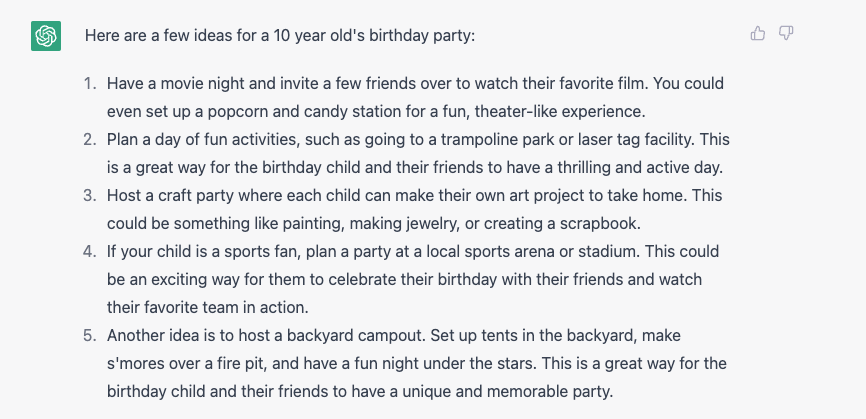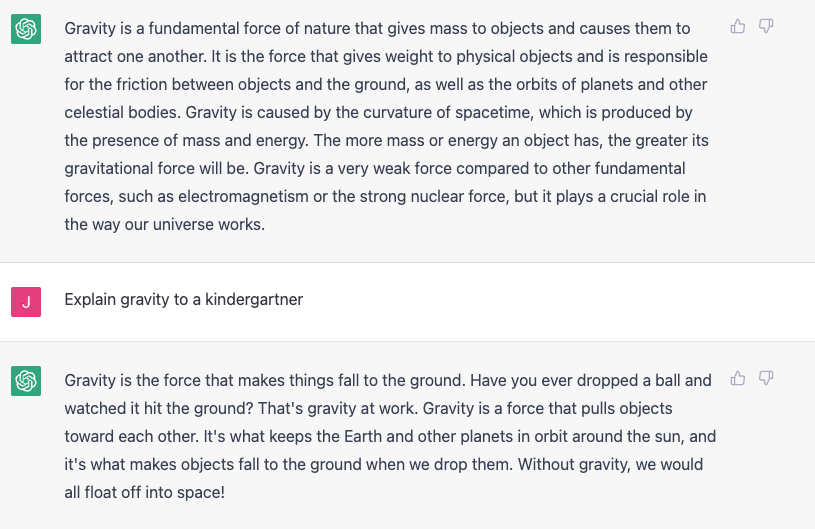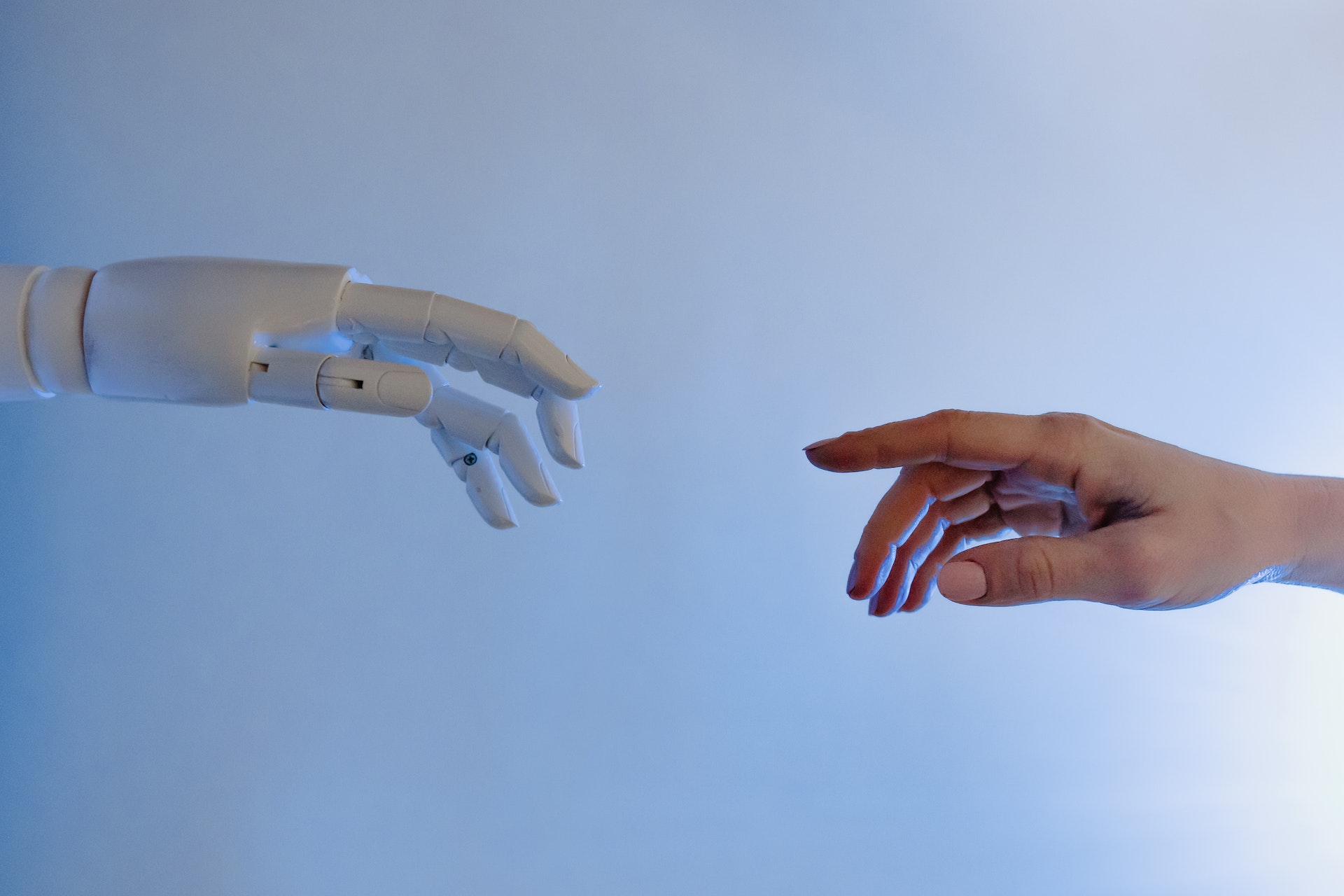Turning 10 is a big milestone for kiddos so when it comes to planning the big celebration, you want it to be fun, entertaining, and a bit unique. In the past - when looking for ideas for my kids' birthdays, I have always googled and discovered blog articles, asked my friends and family, or came up with something on my own. It wasn’t until I tried out the new AI (Artificial Intelligence) feature through ChatGPT that I discovered its ability to not only come up with a plethora of suggestions but that these examples would also be creative. So when I asked, “Got any creative ideas for a 10-year-olds birthday?” In about ten seconds, here’s what ChatGPT told me.

This response stunned me. I used to think that human beings cornered the market on creativity. (Now it is worth noting that ChatGPT did not ‘create’ these answers but rather researched and curated results, only it did it much faster than any human could). It is at this moment when a technology like this is released that we have a choice. We can ban it - as many have done with cell phones in the classroom, and other technology as they arrive to disrupt the status quo - or we can embrace it.
In case you hadn’t heard, Open AI recently released two incredible artificial intelligence tools. Open AI is an organization that describes itself as an “AI research and deployment company. Our mission is to ensure that artificial general intelligence benefits all of humanity.” When I read that I thought, what a UDL-aligned mission! As UDL practitioners we believe that all children can learn and they want to develop artificial intelligence to benefit all of humanity. What a fit! Now, many will wring their hands over their latest products, Chat GPT and InstructGPT but I want to highlight how tools like these can benefit our students and be harnessed much in the way we harnessed the power of graphing calculators in years past.
What is Chat GPT?
There are two products that Open AI has released that will have a profound impact on the lives of our students. One is called ChatGPT and the other is InstructGPT. ChatGPT is artificial intelligence that interacts with the user in a conversational way (like the ideas for the 10 year-olds birthday party)
Here’s where things get interesting. I asked ChatGPT to explain gravity. It gave me an answer. Then I asked ChatGPT to explain gravity to a kindergartner. Then it gave me a more simplistic explanation.

This is where the power comes in. Imagine you are a student in middle school physics and you don’t understand the concept of gravity but you don’t feel comfortable asking that question in class. You can use ChatGPT to find the answer quickly and simply.
Here’s another powerful example in which a user asked ChatGPT to explain Hamlet to a five-year-old.
If this were a student in a high school Shakespeare class, they would be much better positioned to engage in the conversation and take part in the class. This is a resource we should be teaching our students about to help them understand how to use it and become expert learners!
Making AI Work for Educators
There is still much to wrestle with. That same student in the Shakespeare class could ask the ChatGPT to write an essay on Hamlet (which I did and you can read here). The implications of AI’s ability to write essays and papers will disrupt education as outlined here by the Atlantic. When technology innovates, we as educators have to respond by rethinking and adjusting and UDL gives us a great framework to do just that beginning with “what is it that we want all students to learn?”. In the case of Hamlet, it may not be to write an essay. It may be to examine why Hamlet is still relevant. An essay may not be the best tool to do that. ChatGPT forces us to examine what we’ve always done in requiring so much of our learning to be demonstrated through writing. That is not to say that the ability to communicate through writing isn’t important but we have to adapt. Communicating through writing isn’t always the best tool for the job and won’t allow us to reach all students (take a look at this article on choice boards for how students could demonstrate their learning in other ways).
Another fascinating way we could use ChatGPT in the classroom is to have students ask it questions and evaluate the response. Just because a computer told us something doesn’t make it flawless or even true. The skill of thinking analytically and evaluating media and sources is crucial in today’s society and it's what makes an expert learner.
ChatGPT isn’t the only AI tool that is disrupting education
Open AI also has InteractGPT which provides information based on queries but it is not conversational (still a super powerful tool!).
There is another tool called Photomath that uses the power of AI to solve math problems. One of the credos of math used to be, show your work. Now with tools like Wolfram Alpha and Photomath, computers can show all the work for the students. So how will you know if a student knows the information?
These tools in math push us to rethink how we have students show what they know in creative ways that allow them to use these tools as tools, rather than a place to find the answer.
Like all new tools, often our students discover them first. Let’s take AI out of the shadows and bring it into our classroom as a tool that we can explore and make the most of to build expert learners. When harnessed it can make our job easier and empower our students with agency to accomplish things they never thought possible.
How have you used these tools in your classroom? What other AI tools have you discovered and embraced?




